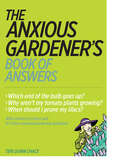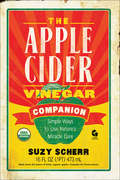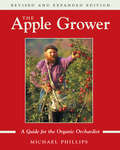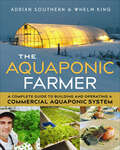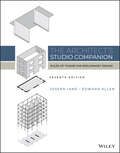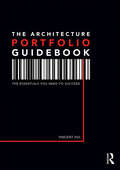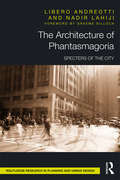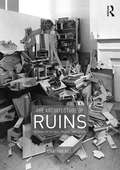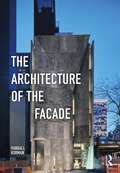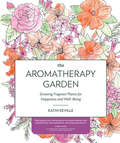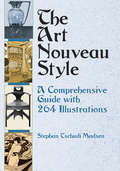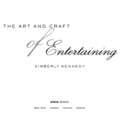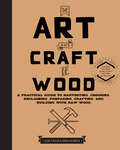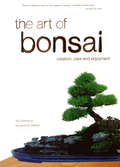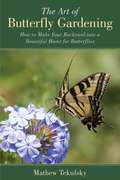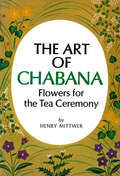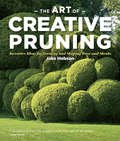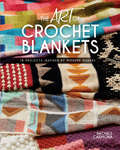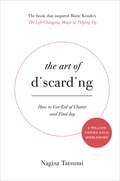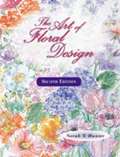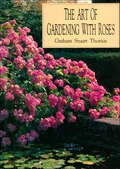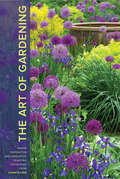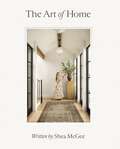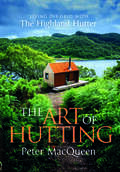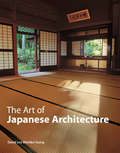- Table View
- List View
The Anxious Gardener's Book of Answers
by Teri Dunn ChaceThe Anxious Gardener's Book of Answers identifies the 100 most common gardening mistakes and gives gardeners the techniques to prevent them. Or, if it's too late and they've already goofed, there are tips to fix the mistake. The book's 24 chapters tackle every kind of gardening disaster, whether it has to do with plants, tools and techniques, or general care and maintenance. Gardeners looking to prune their roses will learn to hold off until late winter to avoid damaging plant tissue. Gardeners that have allowed their mint to overgrow? Dunn advises pulling it out and replanting it in a container to control the root. Organized by common garden topics and designed to be easily dipped in and out of, The Anxious Gardener's Book of Answers offers nuggets of wisdom based on Teri Dunn Chace's years of hands-on gardening experience. Advice is humorously supported by Colleen Coover's delightful illustrations. This accessible guide will transform an anxious gardener into an informed, confident, successful gardener with a mistake-free garden
The Apple Cider Vinegar Companion: Simple Ways to Use Nature's Miracle Cure
by Suzy ScherrThe multitasking superfood is delicious, too! Generations of devotees have sworn by apple cider vinegar: cooking with it, swigging it by the spoonful, and using it as a remedy for just about any ailment. Why? The tart, fermented flavor certainly can add a punch to any recipe, but it’s also great for weight-loss, digestion, and overall good health. It makes a mean natural cleanser, relieves muscle soreness, and even treats bug bites. The Apple Cider Vinegar Companion is the essential guide, with information on how to make your own, and tips and tricks for using it for household tasks. This book stands out from similar titles because of the wonderful recipes, such as: Dill Pickle Potato Salad Easy Homemade Farmer’s Cheese Homemade Spiced Ketchup Raspberry-Peach Shrub Green Tea and Apple Cider Vinegar Tonic
The Apple Grower: Guide for the Organic Orchardist, 2nd Edition
by Michael PhillipsFor decades fruit growers have sprayed their trees with toxic chemicals in an attempt to control a range of insect and fungal pests. Yet it is possible to grow apples responsibly, by applying the intuitive knowledge of our great-grandparents with the fruits of modern scientific research and innovation.Since The Apple Grower first appeared in 1998, orchardist Michael Phillips has continued his research with apples, which have been called &“organic&’s final frontier.&” In this new edition of his widely acclaimed work, Phillips delves even deeper into the mysteries of growing good fruit with minimal inputs. Some of the cutting-edge topics he explores include:The use of kaolin clay as an effective strategy against curculio and borers, as well as its limitationsCreating a diverse, healthy orchard ecosystem through understory management of plants, nutrients, and beneficial microorganismsHow to make a small apple business viable by focusing on heritage and regional varieties, value-added products, and the &“community orchard&” modelThe author&’s personal voice and clear-eyed advice have already made The Apple Grower a classic among small-scale growers and home orchardists. In fact, anyone serious about succeeding with apples needs to have this updated edition on their bookshelf.
The Aquaponic Farmer: A Complete Guide to Building and Operating a Commercial Aquaponic System
by Adrian Southern Whelm King&“The essential guide for people serious about setting up a commercial, cold-water aquaponic system.&” —Dr. Daniel Baker, Department of Fisheries and Aquaculture, Vancouver Island University Profitable cold-water fish and vegetable production. Join the aquaponic farming revolution! Built around a proven 120&’ greenhouse system operable by one person, The Aquaponic Farmer is the game changer that distills vast experience and complete step-by-step guidance for starting and running a cold-water aquaponic farming business—raising fish and vegetables together commercially. Coverage includes: A primer on cold-water aquaponics Pros and cons of different systems Complete design and construction of a Deep Water Culture system Recommended and optional equipment and tools System management, standard operating procedures, and maintenance checklists Maximizing fish and veg production Strategies for successful sales and marketing of fish and plants. As the only comprehensive commercial cold-water resource, The Aquaponic Farmer is essential for farmers contemplating the aquaponics market, aquaponic gardeners looking to go commercial, and anyone focused on high quality food production. Aquaponic farming is the most promising innovation for a sustainable, profitable, localized food system. Until now, systems have largely focused on warm-water fish such as tilapia. A lack of reliable information for raising fish and vegetables in the cool climates of North America and Europe has been a major stumbling block. The Aquaponic Farmer is the toolkit you need. &“Provides almost a step by step cookbook on all pertinent aspects of aquaponics and is based upon the authors&’ experiences from their own successful farm.&” —Michael B. Timmons, PhD & PE, Professor Biological & Environmental Engineering, Cornell University
The Architect's Studio Companion: Rules of Thumb for Preliminary Design
by Edward Allen Joseph IanoTHE ARCHITECT’S STUDIO COMPANION The latest edition of the guidebook every architect needs at their fingertips, updated and expanded throughout Start your designs on solid ground with The Architect’s Studio Companion! This comprehensive handbook provides everything you need for the preliminary selecting, configuring, and sizing of the structural, environmental, safety, accessibility, and parking systems of a building. Edward Allen and Joseph Iano, authors of the market-leading Fundamentals of Building Construction, use their trademark talent for boiling down complex technical requirements into easy-to-use, time-saving guidelines for the engineering and architectural design of buildings. The new seventh edition is updated with new building codes, new information on heating and cooling systems for buildings, new structural systems, new requirements for tall mass timber buildings, and more. Throughout the text, straightforward diagrams and user-friendly explanations help you lay out the most important systems of a building in a matter of minutes without stressing about complicated technical concepts. Use this guide to introduce building systems into the early stages of design, and greatly reduce the need for later revisions or redesign???and keep your projects on time and on budget. Streamline your design process today with The Architect’s Studio Companion: Explore alternative structural systems quickly and efficiently Compare the carbon impacts of alternative system choices… at a glance Stay current with the latest information about tall mass timber buildings Access information on high-performance heating and cooling systems, passive design, natural daylighting, and other sustainable design strategies with ease Incorporate U.S. and Canadian building code requirements and accessibility regulations into your designs More than just a reference, The Architect’s Studio Companion, Seventh Edition is a must-have companion that no practicing architect or student should be without.
The Architecture Portfolio Guidebook: The Essentials You Need to Succeed
by Vincent HuiThe Architecture Portfolio Guidebook shows you how to make portfolios for both academic and professional needs to provide reviewers exactly what they are looking for. In school, architecture curricula nurture the knowledge and skills to develop design work to varying levels of presentation. In the profession, those skills are further developed and applied in the creation of the built environment. In both contexts, a portfolio is a core component for admission and advancement. This book provides key strategies to: • develop an understanding of the unique needs of professional and academic organizations; • identify applicants’ key differentiators; • highlight how applicants present themselves in their portfolios to address institutional needs; • create successful reinforcing documentation; • communicate using portfolios. Rather than proposing generic solutions, this book details the successful practices for portfolio creation by addressing portfolio creation academically and professionally. Supporting insights and examples from leading academics and architects from around the world reinforce the themes presented in this guidebook. An ideal read for students and professionals of architecture, landscape architecture, interior design, and urban design, looking to advance their studies and careers.
The Architecture of Phantasmagoria: Specters of the City
by Nadir Lahiji Libero AndreottiIn a time of mass-mediated modernity, the city becomes, almost by definition, a constitutively ‘mediated’ city. Today, more than ever before, the omnipresence of media in every sphere of culture is creating a new urban ontology, saturating, fracturing, and exacerbating the manifold experience of city life. The authors describe this condition as one of 'hyper-mediation' – a qualitatively new phase in the city’s historical evolution. The concept of phantasmagoria has pride of place in their study; using it as an all-embracing explanatory framework, they explore its meanings as a critical category to understand the culture, and the architecture, of the contemporary city. Andreotti and Lahiji argue that any account of architecture that does not include understanding the role and function of media and its impact on the city in the present ‘tele-technological-capitalist’ society is fundamentally flawed and incomplete. Their approach moves from Walter Benjamin, through the concepts of phantasmagoria and of media – as theorized also by Theodor Adorno, Siegfried Kracauer, and a new generation of contemporary critics – towards a new socio-critical and aesthetic analysis of the mediated space of the contemporary city.
The Architecture of Ruins: Designs on the Past, Present and Future
by Jonathan HillThe Architecture of Ruins: Designs on the Past, Present and Future identifies an alternative and significant history of architecture from the sixteenth century to the twenty-first century, in which a building is designed, occupied and imagined as a ruin. This design practice conceives a monument and a ruin as creative, interdependent and simultaneous themes within a single building dialectic, addressing temporal and environmental questions in poetic, psychological and practical terms, and stimulating questions of personal and national identity, nature and culture, weather and climate, permanence and impermanence and life and death. Conceiving a building as a dialogue between a monument and a ruin intensifies the already blurred relations between the unfinished and the ruined and envisages the past, the present and the future in a single architecture. Structured around a collection of biographies, this book conceives a monument and a ruin as metaphors for a life and means to negotiate between a self and a society. Emphasising the interconnections between designers and the particular ways in which later architects learned from earlier ones, the chapters investigate an evolving, interdisciplinary design practice to show the relevance of historical understanding to design. Like a history, a design is a reinterpretation of the past that is meaningful to the present. Equally, a design is equivalent to a fiction, convincing users to suspend disbelief. We expect a history or a novel to be written in words, but they can also be delineated in drawing, cast in concrete or seeded in soil. The architect is a ‘physical novelist’ as well as a ‘physical historian’. Like building sites, ruins are full of potential. In revealing not only what is lost, but also what is incomplete, a ruin suggests the future as well as the past. As a stimulus to the imagination, a ruin’s incomplete and broken forms expand architecture’s allegorical and metaphorical capacity, indicating that a building can remain unfinished, literally and in the imagination, focusing attention on the creativity of users as well as architects. Emphasising the symbiotic relations between nature and culture, a building designed, occupied and imagined as a ruin acknowledges the coproduction of multiple authors, whether human, non-human or atmospheric, and is an appropriate model for architecture in an era of increasing climate change.
The Architecture of the Facade
by Randall KormanThe Architecture of the Facade provides a comprehensive study of the facade as both a physical and cultural artifact, highlighting its significance as a critical component of the civic realm and arguing for the restoration of the art of the facade as both a subject of study within academia and an aspiration within the profession at large. As the principal surface of mediation, contextualization, and representation, the facade carries the lion’s share of responsibility for containing the internal environment and confronting the outer world. And yet, in recent decades, the very question of what exactly a facade is has been raised by the dramatic changes in building technology, advances of parametric design, and the ubiquity of autonomous buildings. The Architecture of the Facade addresses these and other related issues. The book is organized into 12 chapters, with each chapter focusing on a particular aspect of the phenomenon of the facade such as those of wall, the frame, transparency, and the role of the facade in civic space. Korman also discusses proportional systems, the language of composition, the role of precedent, the importance of context, and much more. Over 350 photos and diagrams provide readers with a variety of examples of artful facades throughout history. Online teaching resources that accompany this book include a course syllabus, a glossary, and a Pinterest tack board of facades. This book will be of great interest to students in architecture studios as well as instructors and professional architects interested in facade design.
The Aromatherapy Garden: Growing Fragrant Plants for Happiness and Well-Being
by Kathi Keville“Kathi guides you to all the joys of an aromatic garden with wonderful tips, fascinating facts, and sumptuous photos.” —Mandy Aftel, acclaimed natural perfumer and author of Essence and Alchemy and FragrantThe Aromatherapy Garden explains how fragrant plants can be as therapeutic as they are intoxicating, and how easy it is to add this captivating element to gardens large and small. It reveals the scents, secrets, and science behind fragrant plants, and how to optimize the full benefits of fragrance. Hone your powers of concentration with lemon verbena. Beat the blues with wintersweet. And use rose geranium to relieve anxiety and stress. Revealed here are the scents, secrets, and science behind plant aromatherapy, and how to optimize its full benefits. Detailed plant profiles will help you create a beautiful source of restorative aromas, oils, sachets, teas, and more. The nose knows—and with Keville’s expertise, now you too can create your own sanctuary of health and happiness
The Art Nouveau Style: A Comprehensive Guide with 264 Illustrations
by Stephan Tschudi MadsenA revolutionary reaction to traditional nineteenth-century art, the turn-of-the-century Art Nouveau movement drew much of its inspiration from nature. Applying its sinuous, curvilinear motifs to the decorative arts, graphics, architecture, sculpture, and painting, artists and craftspeople attempted to create a style suitable for a "modern" age. In this absorbing, exceptionally detailed, and well-researched book (one of the first scholarly works to revive interest in the style after World War II), a noted Norwegian authority on the subject examines the movement in depth. Stephan Madsen offers a wealth of facts and insights about the origins and development of the style; trends leading up to Art Nouveau, including the influence of Blake and the Pre-Raphaelites; early Art Nouveau posters and book illustrations; and its use in architectural ornamentation, furniture, jewelry, wrought-iron, glass, and other applied arts. A magnificent selection of 264 photographs and line drawings accompanies the text, which gives broad coverage to the movement, as well as insightful discussions of such important artists as Emile Gallé, Alphonse Mucha, Walter Crane, Charles Rennie Mackintosh, Aubrey Beardsley, Henry Van de Velde, Victor Horta, William Morris, and Eugène Grasset.Artists and students, admirers of Art Nouveau, and anyone interested in this enduring and influential style will welcome Professor Madsen's expert, fully documented study.
The Art and Craft of Entertaining
by Kimberly KennedyWhere do I begin? That's the question we start with when thinking about throwing a party -- and for many of us, that's the question we end with, too. We may like the idea of entertaining friends and family in our home, but the details -- those how to's of planning the party, making the food, and playing hostess -- can quickly overwhelm us, prompting us to tuck away the idea, waiting for another, better time. But it doesn't have to be that way. With The Art and Craft of Entertaining, author Kimberly Kennedy provides all the information and inspiration you need to plan, organize, and carry out a successful no-stress event. Marry some of her ideas with your own, and you'll be on the way to developing your style, gaining confidence as a hostess and elsewhere in your life. Whether you're throwing a cocktail party, a baby shower, or an intimate dinner for two, The Art and Craft of Entertaining will take you there, step-by-step. Instructive and encouraging, this essential book lays the groundwork for entertaining with style, demonstrating how to craft a perfect invitation for any occasion, organize your supplies into versatile and efficient arsenals, and plan a satisfying meal without breaking your budget. The Art and Craft of Entertaining shows how to mix passion with planning so that you can throw the party of your dreams. Inspiration without intimidation. That's The Art and Craft of Entertaining.
The Art and Craft of Wood: A Practical Guide to Harvesting, Choosing, Reclaiming, Preparing, Crafting, and Building with Raw Wood
by Silas J. KylerThe Art and Craft of Wood shows you how to mill, stack, dry, and flatten a log into useable lumber and build a variety of household furnishings. Trees are all around us. They provide shade, beautify our neighborhoods, filter our water, and clean our air, but when they die, we often don't know what to do with them. Now you can learn the skills to reclaim those trees as lumber. Perfect for the woodworking hobbyist, The Art and Craft of Wood introduces readers to the basics of wood craft. The Art and Craft of Wood will inspire you to make something of your own through simple, step-by-step photos. As a reader, you will learn valuable skills, including:Where to find wood that you can reclaim for your own useHow to mill, stack, dry, and flatten your log into useable lumberCreate a variety of useful household furnishings in 7 step-by-step projects ranging in difficulty from novice to more complicatedWhat to do with leftover material, such as making firestarters and animal beddingAuthors Silas Kyler and David Hildreth are also the filmmakers behind the documentary Felled, a film about giving new life to urban trees; they have lived the process of refining wood. The Art and Craft of Wood is their guide to you!
The Art of Bonsai
by Giovanna M. Halford Yuji YoshimuraLearn the ins and outs of proper bonsai design and care with this comprehensive Japanese gardening book.Japanese bonsai have long been admired throughout the world while their care and preservation have seemed shrouded in mystery. The Art of Bonsai is, however, a comparatively simple art to learn. Anyone with a love a plants, a little patience and this eminently practical book can create bonsai and keep a finished plant healthy and vigorous for generations.Included in this definitive volume are:Detailed, illustrated instructions on propagation and trainingHints for those growing bonsai in a hurry and apartment dwellersDaily and seasonal bonsai care practicesDealing with pests and bonsai troubleshootingHow to judge, select and exhibit bonsaiDetailed appendices on tools, equipment, soil analysesData on more than 300 species of plants used in making bonsaiThis classic work remains an eminently practical book and is the classic guide to bonsai care. It contains the essentials of an art that is one of Japan's most treasured traditions--sculpting beauty in living wood.
The Art of Butterfly Gardening: How to Make Your Backyard into a Beautiful Home for Butterflies
by Mathew TekulskyButterfly gardening is the practice of attracting beautiful butterflies to your garden by growing common plants and flowers that they use for food and nectar. This fun and wonderfully simple activity will bring color, light, and beauty to your garden and home. With the relaxing and rewarding qualities of this outdoor hobby, it’s not hard to see why it’s sweeping the nation and growing in popularity. Mathew Tekulsky’s The Butterfly Garden is a complete, step-by-step guide to gardening for butterflies. You’ll learn about: * The butterfly life cycle, habitats, and behaviors * Choosing and obtaining food and nectar sources * Designing your garden * Options for country, suburban, and city gardens * Fifty common garden butterflies and the plants they like * Butterfly observation and conservation This guide will teach you everything you need to get started--whether you’re a suburban resident, the owner of a small urban garden, an apartment dweller, or a keeper of a country estate, you can enjoy frequent butterfly visits to your garden or window box. The key, Tekulsky believes, is learning some basic knowledge of butterfly characteristics and behavior and knowing how to meet the needs of the butterfly species most common in your neighborhood. Not only is butterfly gardening one of the easiest ways to enjoy these enchanting creatures, but it’s also a wonderful way to help conserve natural butterfly populations for generations to come. Learn how to create your own beautiful butterfly garden today!
The Art of Chabana
by Henry MittwerChabana is a simple arrangement of floral or other plant material traditionally placed in the tokonoma, or alcove, of the room in which the tea ceremony is performed. There are no rules in arranging Chabana, the author tells us, no specail measurements or geometric patterns, Rather, the creator of a Chabana must use his imagination and, most of all, a special inspiration from within. The author does give some practical guidelines, however, on the minutiae of arranging a Chabana. And he discusses in length more than 100 flowers that are suitable for Chabana, explaining exactly how they can be used and the most appropriate seasons for their display. The book includes a complete list of plants with names in English, Japanese, and Latin.
The Art of Creative Pruning: Inventive Ideas for Training and Shaping Trees and Shrubs
by Jake HobsonNothing brings a touch of artistry to the garden like ornamental pruning, and a series of deliberate cuts can create landscapes and evoke faraway places. All that's needed to recreate the effect in the garden are a sharp pair of pruners, some imagination, and the instruction found in The Art of Creative Pruning. Drawing on both eastern and western styles, author Jake Hobson moves beyond the traditional lollipops and animals and teaches a wholly new approach to ornamental pruning that appeals to modern sensibilities. Picture boxwoods trimmed into whimsical Russian nesting dolls, hedges inscribed with words, and a tree snipped to resemble the toppling tiers of a wedding cake. These are just a few of the unusual ideas featured in the beautifully photographed pages. All the practical considerations are here as well, including pruning to improve a view, remedial pruning to fix problems, and pruning fruit trees to increase yield.
The Art of Crochet Blankets: 18 Projects Inspired by Modern Makers
by Rachele CarmonaDiscover a new source of inspiration for your crochet hook...the beautiful work of today's modern makers! Follow popular crochet blanket designer Rachele Carmona through her unique collection of crochet blankets inspired by the work of popular independent artists. The Art of Crochet Blankets will help you create your own colorful crochet blankets as unique works of art for your home! Inside this one-of-a-kind crochet blanket guide you'll find: • Details on how to translate art to hook with 18 bold and unique crochet afghan patterns influenced by the works of their feature artist. • Modern quilts, fabric designs, tapestry weaving, digital art, and more become the source of one-of-a-kind projects for a more artful home. • Biographies and beautiful photos profiling 6 inspiring modern makers--Tula Pink, April Rhodes, Maryanne Moodie, Fransisco Valle, Maud Vantours, and Caitline Dowe-Sandes. Discover the inspiration that lies beyond the world of crochet with The Art of Crochet Blankets.
The Art of Discarding: How to Get Rid of Clutter and Find Joy
by Nagisa TatsumiThe book that inspired Marie Kondo's The Life Changing Magic of Tidying Up, Nagisa Tatsumi's international bestseller offers a practical plan to figure out what to keep and what to discard so you can get - and stay - tidy, once and for all.Practical and inspiring, The Art of Discarding (the book that originally inspired a young Marie Kondo to start cleaning up her closets) offers hands-on advice and easy-to-follow guidelines to help readers learn how to finally let go of stuff that is holding them back--as well as sage advice on acquiring less in the first place. Author Nagisa Tatsumi urges us to reflect on our attitude to possessing things and to have the courage and conviction to get rid of all the stuff we really don't need, offering advice on how to tackle the things that pile up at home and take back control. By learning the art of discarding you will gain space, free yourself from "accumulation syndrome," and find new joy and purpose in your clutter-free life.
The Art of Floral Design (2nd Edition)
by Norah T. HunterThe Art of Floral Design, second edition is a textbook designed to take the student from basic to advanced floral design techniques. With a well-balanced presentation of theory and practice this textbook sets the standard for teaching floral design techniques. Topics covered include the principles and mechanics of flower arranging, basic flower anatomy, as well as arrangement styles for a variety of special occasions. Updated to reflect the latest concepts and practices, this new second edition will place students at the forefront of floral design.
The Art of Gardening with Roses
by Graham Stuart ThomasGraham Stuart Thomas stands alone as the world's pre-eminent rose gardener. In this unique presentation he focuses on the uses of a variety of garden plants--flowering and nonflowering--with which to create enduring garden designs that rescue roses from the stiff formality of most ornamental gardens. Here, Mr. Thomas employs the lessons of the magnificent garden at Mottisfont Abbey, first created by him in 1972 and extended in the 1980s, to demonstrate thrilling design choices and methods of lengthening the flowering seasons open to any alert gardener. As Henry Mitchell, the Washington Post's distinguished horticulturist, puts it: "It was Thomas who launched the revival of interest in roses long out of commerce...He found many of the unheard-of nineteenth-century roses at Bobbink and Atkins Nursery in New Jersey and the old Lester and Tillotson Nursery in California. The authority of Graham Stuart Thomas is by no means limited to roses. He writes authoritatively on perennials, garden design, the grouping of plants, on groundcovers and much else...Few gardeners are so catholic or such connoisseurs."The present book is a glorious display--in words and color illustrations--of Mr. Thomas's gardens, providing an education for the reader in the design of his own garden. Photographs show roses close up and in garden settings with complementary plants that extend the flowering season of the gardens into the late fall. The author explores the origins of the roses selected and explains how he has employed their particular qualities in his designs. He includes a checklist to assist gardeners who wish to re-create these sumptuous plant combinations.
The Art of Gardening: Design Inspiration and Innovative Planting Techniques from Chanticleer
by R. William Thomas“Delightful!” —The New York Times Book Review Discover a world of beauty and creativity! Chanticleer has been called the most romantic, imaginative, and exciting public garden in America. It is a place of pleasure and learning, relaxing yet filled with ideas to take home. And now those lessons are available for everyone in this stunning book! You’ll learn techniques specific to different conditions and plant palettes; how to use hardscape materials in a fresh way; and how to achieve the perfect union between plant and site. And Rob Cardillo’s exquisite photographs of exciting combinations will be sure to stimulate your own creativity. Whether you’re already under Chanticleer’s spell or have yet to visit, The Art of Gardening will enable you to bring the special magic that pervades this most artful of gardens into your own home landscape.
The Art of Home: A Designer Guide to Creating an Elevated Yet Approachable Home
by Shea McGeeThe long-awaited design book from Shea McGee, beautifully showcasing all that is possible for every room of your home.Whether it's through her thriving design business, Studio McGee, her popular Netflix series, Dream Home Makeover, or her online community of over five million followers, Shea McGee has shown the world how the principles of high-end design can be applied to any home. As the title of her new book suggests, designing rooms for maximum impact while also remaining approachable to any who enter is an art. But it's also a skill that can be learned because it's inside each one of us.In The Art of Home, Shea takes us through every room of the house, starting with an explanation of process and then guiding our entryways, living rooms, kitchens, offices, kids' rooms, and even our utility rooms. With step-by-step guides paired with her own design projects and the power of her personal stories, Shea helps us transform the most important parts of our lives and how we live.What I love about design is the opportunity to dream and then will that vision into existence.Join Shea as she teaches us to dream and then shows us how to make it reality. Her new book, The Art of Home, is as functional as it is heart-stoppingly beautiful and it will maintain a presence in your home for years to come.
The Art of Hutting: Live Off-Grid with The Highland Hutter
by Peter MacQueenLiving Off-the-Grid in ScotlandDon’t just experience Scottish history. Live it with The Art of Hutting, the essential beginner’s guide to sustainable living off the grid.Experience Scotland like never before. The Land of the Brave has so much to see and offer, but nothing is more breathtaking than living in its natural beauty. So how does one live away from the cities of Scotland? Inspired by traditional and modern shelter techniques, hutting expert Peter MacQueen shares how to live off the grid in The Art of Hutting. Each chapter answers many your questions about local sustainable living, from the safest bushcraft tools to growing a bountiful garden for every season. That way, you can be prepared to create your forever home and make memories in the untamed heart of Scotland.Create your own cozy Scottish hideaway. Along with learning the necessary outdoor skills to live off Scotland’s resources, this self-sufficient living book also shares how to create the hut of your dream. Off-grid living has never been cozier than with MacQueen’s hutting tips and tricks, from constructing the perfect eco-design to finding natural building materials. And with visual examples of local huts and cottages to choose from, you can create your next home with all the beauty and wonders the Scottish highlands and lowlands have to offer.Inside The Art of Hutting, you’ll also find:Best locations for hut buildingHow to create a wildlife garden made from Scotland’s natural vegetationRecommendations for fire-starter tools and firewood storageIf you liked books such as Thrive, Clansland Almanac, or Surviving the Wild, then you’ll love The Art of Hutting.
The Art of Japanese Architecture
by David Young Michiko Young Tan Hong YewThe Art of Japanese Architecture explores the simplicity, asymmetry, sensitivity to the natural environment, and use of natural materials that are the hallmarks of Japanese architecture. These elements are explored and clarified in this cultural and historical overview of the rapidly changing world of Japanese architecture.Beginning with a discussion of prehistoric pit dwellings and concluding with a description of significant modern buildings, David and Michiko Young, authors of the 2006 American Horticultural Award-winning book, The Art of the Japanese Garden, analyze the major changes in architecture caused by the introduction of Buddhist culture, the development of feudalism, the influence of Western culture and the adaptation of the international style in contemporary buildings.
